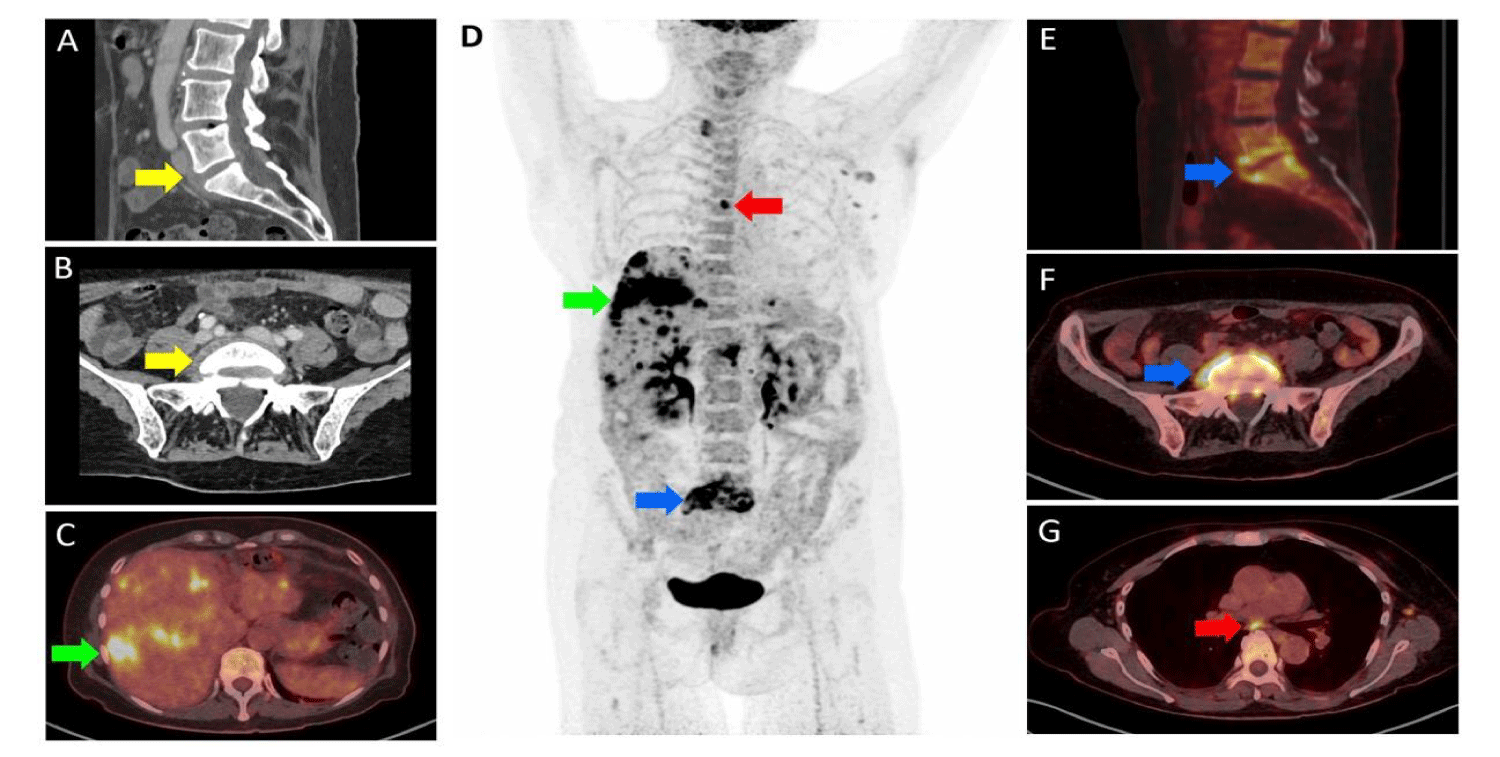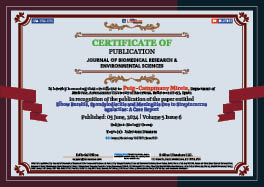Biology Group. 2024 June 05;5(6):515-518. doi: 10.37871/jbres1921.
Elbow Bursitis, Spondylodiscitis and Meningitis Due to Streptococcus agalactiae: A Case Report
Albuixech-Ginesta M2,4, Villarejo-Jimenez A1,2,4, Velasco-Nuño M3,4, Serrano-Herran M2,4, Perez-Mendez MC1,2,4, Lazzari R1,2,4 and Puig-Campmany M1-4*
2Emergency Department, Hospital de la Santa Creu i Sant Pau, Barcelona 08025, Spain
3Nuclear Medicine Department, Barcelona 08025, Spain
4Sant Pau Research Institute, Barcelona 08025, Spain
E-mail:
- Bacterial infections
- Sepsis
- Streptococcal infections
- Emergency department
- Older adult
Abstract
The incidence of S.agalactiae infection in older adults is increasing, especially in those with comorbidities. During the last four decades, invasive infections in adults unrelated to pregnancy have been increasingly reported. In these cases, a frequent underlying cause is osteoarticular or soft-tissue infection.
In older adults, spondilodyscitis should be considered in the Emergency Department (ED) in patients with subacute symptoms of the locomotor system, which may be mistakenly classified as mechanical in origin, until the onset of fever. Lumbar CT for diagnosing spondylodiscititis in the early days of symptoms may not be enough sensitive, so other diagnostic tests such as magnetic resonance imaging or PET-CT with 18F-FDG are useful. In ED, a high index of suspicion is needed since this is a serious and life-threatening disease and potentially fatal disease.
Introduction
S.agalactiae is a Group B Streptococcus (GBS) that frequently colonizes cultures of the rectum, vagina, cervix, urethra, skin and pharynx and causes neonatal and puerperal sepsis. In adults, there is a rising incidence of 4.4 cases per 100,000 inhabitants, probably related to population aging and chronic diseases [1,2]. The risk factors for invasive GBS infection are advanced age, diabetes, renal failure, cancer, liver disease and cerebrovascular disease.
In older adult, skin and soft tissue infections, non-focal bacteremia, urinary tract infections and, less frequently, endocarditis, central nervous system infections and osteo-articular infections stand out [2-6]. GBS spondylodiscitis is predominantly male (2:1), between 55 and 70 years of age, with a predilection in the lumbosacral area [3,7]. The most frequent predisposing factors are diabetes mellitus and neoplasias.
Spondylodiscitis is a challenging disease [8]. It usually begins with a progressive onset of pain of increasing severity, initially without fever, that in older people can easily be confused with pain of mechanical origin. A normal spinal radiology is characteristic at presentation and lumbar CT may not be enough sensitive in early stages. A high index of suspicion is required in the ED. It may be necessary to use further tests such as magnetic resonance imaging or PET CT to reach a diagnosis as soon as possible, since this is a serious and life-threatening disease as it is a serious and potentially fatal disease, usually accompanied by bacteremia.
The incidence of neurological complications in adults with invasive infection due to this pathogen is not known, but the following have been described: epidural abscess secondary to spondylodiscitis with spinal cord compression, acute bacterial meningitis, ischemic stroke as a presentation of bacterial endocarditis and meningoventriculitis after neurosurgery and ventricular shunt. CNS infection is rare, and almost always in the form of meningitis. It accounts for 0.3 to 4.3% of all bacterial meningitis [5].
S.agalactiae, penicillin is the treatment of choice. The duration of treatment will vary according to the extent of invasive disease [9].
Case Report
We present a 68-year-old woman with penicillin allergy (tolerant to third-generation cephalosporins, carbamepens) and anaphylactic shock after paclitaxel administration. Her only relevant history was a high-grade ovarian serous carcinoma with hepatic and retroperitoneal metastases, which underwent surgery six months earlier. She had recieved carboplatin since then.
She started low back pain 15 days before consulting the Emergency Department (ED). The pain was acute in onset, and had motivated a previous consultation in another ED. After performing a lumbar X-ray, she was discharged, diagnosed with mechanical low back pain and treatment with Nonsteroidal Anti-Inflammatory Drugs (NSAIDs) was indicated.
The pain did not improve, and the patient consulted our ED due to the onset of fever in the last 3 days, malaise and somnolence. She had not headache, cough, micturition syndrome, diarrhea or other symptoms other than back pain.
Physical examination showed she was prostrate, with fever (37.6ºC), blood pressure 120/60 mmHg, heart rate 89 bpm, respiratory rate 19 rpm, oxygen saturation of 99%, and Glasgow Score 15.
In the physical examination cardiorespiratory auscultation showed no respiratory sounds or heart murmurs. Skin and locomotor system examination showed a painful erythematous plaque of the left elbow and pain on lumbar espinal palpation. The neurological examination was normal.
The patient was diagnosed with left elbow bursitis, with possible associated bacteremia, and 1 g of Cetriaxone and 600 mg of intravenous Clindamycin were started immediately.
A basic CBC with blood gases and two serial blood cultures were immediately performed. Venous blood gases, showed Ph 7.47, pCO2 54 mmHg, HCO3 27 mEq/L, lactate 1.2mMol/L. Urgent CBC showed hemoglobin 9.3 g/L; leukocyte count 10x109/L with 67% neutrophils. C-reactive protein was 461 mg/dL, and procalcitonin was 0.40 ng/mL. Renal and liver function were normal, as was the ionogram. A urine sediment was negative.
Within 3 hours of her arrival, A CT scan of the left elbow was performed and showed cellulitis on back of forearm, with minimal bursitis (<10 mm). A cranial CT scan was also performed which was normal.
Six hours after the patient's arrival, the laboratory reports gram-positive cocci growth in blood cultures. On re-evaluation, possible nuchal rigidity was noted, with positive Kerning's and Brudzinski's signs.
With diagnostic guidance of gram-positive cocci bacteremia, left elbow bursitis, probable spondylodiscitis and meningeal involvement a lumbar puncture was performed. This showed hyperproteinuria of 1.29 g/L, hypoglycorrhachia of 1.5 mmol/L with 181 cells with 42% neutrophils, 40% lymphocytes and 18% monocytes, and the CSF gram showed no germs. The antibiotherapy was extended with Vancomycin 15 mg/Kg/12 hours, Ceftriaxone (1 gr) and Ampicillin 200 mg/Kg (2 gr every 6 hours).
A lumbar CT scan was performed which showed L4-L5 and L5-S1 degenerative disc disease, with a voluminous posterior hernia with superior migration in L5-S1 and stenosis of the right conjunctival foramen, also in L5-S1. No signs of vertebral or paravertebral infection were observed. The patient was transferred to ED observation unit for control.
24 hours after arrival at the ED, the gram-positive cocci were identified as S.agalactiae. CSF culture was negative. The therapeutic regimen was adjusted with only Ceftriaxone 2 g/12h.
She was diagnosed with S.agalactiae sepsis, with bursitis and meningeal involvement. With a diagnostic suspicion of spondylodiscitis as the primary cause of the sepsis, despite of the negative lumbar CT scan, a Positron Emission Tomography (PET-CT) scan with 18F-FDG was carried out 36 hours after arrival showing a L5-S1 spondylodiscitis and tumor progression (Figures 1,2).
Tran’s esophageal echocardiography showed no abnormalities or presence of vegetations. She was transferred to the infectious diseases ward. Finally, she was discharge under home hospitalization until she completed 4 weeks of ceftriaxone 4g per day.
This case is an example of an older adult patient with malignancy as a predisposing cause of invasive S.agalactiae disease. Skin or soft tissue infection is one of the most frequent causes of S.agalactiae bacteremia, as reported by literature. However, in the reported case, once diagnosed by bursitis and bacteriemia, spondylodiscitis had to be ruled out since back pain was the main and earliest symptom.
Osteoarticular infections due to S. agalactiae are rare. The most frequent location is described in the metatarsophalangeal joints of the toes in diabetic patients, followed by lumbosacral, knee, hip and shoulder involvement [2]. In a 2005 review of all cases published to date, 33 cases of spondylodiscitis caused by S.agalactiae in adults were described. Of all these cases, there was a predominance of males (frequency 2:1), the age range of 55 to 70 years, the greater vertebrodiscal involvement compared to isolated vertebral involvement, and the most frequent location in the lumbosacral region. Extravertebral extension with paravertebral or epidural abscesses was present in 47% of the cases. The most frequent predisposing factors were diabetes mellitus and neoplasms [2].
In this patient, given the probability that spondylodiscitis was the primary cause of S. Agalactiae sepsis, despite a negative CT scan, a PET-TC was performed which was diagnostic. This is relevant, since spondylodiscitis requires a longer treatment than only bursitis or sepsis and incorrect treatment can lead to recurrence or relapse.
The patient showed an altered cephalorachidian fluid. Although no germs were isolated, the patient suffered during the first hours of stay a worsening of consciousness, which could be explained by sepsis, but also by an associated meningeal involvement. We think that clinical and analytical meningitis without germ could be explained by having received antibiotherapy on arrival at the ED previous to lumbar puncture. However, it is also possible that it is an inflammation caused by continuity or by low inoculum.
Finally, as lessons learned in this case, first, we would like to emphasize that the incidence of S. agalactiae infection in older adults is increasing, especially in those with comorbidities, and a high index of suspicion in the emergency department is needed. So, this possibility should be considered in case of febrile symptoms accompanied by subacute symptoms of the locomotor system, which may be mistakenly classified as mechanical in origin, until the onset of fever. Second, it should be noted that lumbar CT for diagnosing spondylodiscititis in the early days of symptoms may not be enough sensitive, so other diagnostic tests such as magnetic resonance imaging or PET-CT with 18F-FDG are useful in ED [8].
Ethical Guidelines
The IIBSant Pau CEIC approved the review of this case. Informed consent was requested from the patient.
Conflict of Interest
The authors declare that they have no conflicts of interest.
References
- Armistead B, Oler E, Adams Waldorf K, Rajagopal L. The Double Life of Group B Streptococcus: Asymptomatic colonizer and potent pathogen. J Mol Biol. 2019 July 26; 431(16): 2914–31. doi:10.1016/j.jmb.2019.01.035. Epub 2019 Jan 31. PMID: 30711542. PMCID: PMC6646060
- Morven SE, Baker CJ. Group B Streptococcus bacteriemia in the elderly. Clin Infect Dis. 2005 Sep 15;41(6):839-47. doi: 10.1086/432804. Epub 2005 Aug 16. PMID: 16107984.
- Díaz-Gonzálvez E, Zarza B, Abreu P, Cobo J, Orte J, Dronda F. Espondilodisctis y sacoroileítis por Streptococcus agalactiae en adultos: caso clínico y revisión de la literatura. Enfermedades Infecciosas y Microbiología Clínica 2005 Feb; 23 (2):71-5. doi: 10.1157/13071609. PMID: 15743577.
- Jackson L A, Hilsdon R, Farley M, Harrison L, Reingold, Plikaytis B, Wenger J. Risk factor for group B streptococcal disease in adult. Ann intern Med 1995 Sep 15;123(6):415-20. doi: 10.7326/0003-4819-123-6-199509150-00003. Epub 1995 Sep 15. PMID: 7639440.
- Oyanguren B, Esteban L, Guillán M, de Felipe A, Alonso Cánovas A, Navas E, Quereda C, Corral I. Afectación del sistema nervioso central en la infección invasiva por Streptococcus agalactiae en adultos. Neurología 2015 April; 30 (3):158–62. doi: 10.1016/j.nrl.2013.12.002. Epub 2014 Sep 10. PMID: 25217065.
- Farley MM, Harvey C, Stull T, Smith JD, Schuchat A, Wenger J, Stephens D. A population-based assessment of invasive disease due to group B Streptococcus in nonpregnant adults. N Engl J Med 1993 Jun 24;328(25):1807-11. doi: 10.1056/NEJM199306243282503. PMID: 8502269.
- Gómez Rodríguez N, Penelas-Cortés Bellas Y, Chorén Durán ML, De la Puente MC. Pyogenic arthritis caused by Streptococcus agalactiae: report of four cases and a review of the literatura. Reumatol Clin. 2010 May; 6(3):148-52. doi: 10.1016/S2173-5743(10)70034-4. Epub 2010 Feb 12. PMID: 21794702
- Lazzeri E, Bozzao A, Cataldo MA, Petrosillo N, Manfrè L, Trampuz A, Signore A, Muto M. Joint EANM/ESNR and ESCMID-endorsed consensus document for the diagnosis of spine infection (spondylodiscitis) in adults. Eur J Nucl Med Mol Imaging 2019 Nov;46(12):2464-87. doi: 10.1007/s00259-019-04393-6. Epub 2019 Aug 9. PMID: 31399800.
- Muñoz P, Llancaqueo A, Rodríguez-Créixems M, Peláez T, Martín L, Bouza E. Group B streptococcus bacteremia in nonpregnant adults. Arch Intern Med. 1997; Jan 27;157(2):213-6. doi: 10.1001/archinte.1997.00440230087011. PMID: 9009979.
Content Alerts
SignUp to our
Content alerts.
 This work is licensed under a Creative Commons Attribution 4.0 International License.
This work is licensed under a Creative Commons Attribution 4.0 International License.










